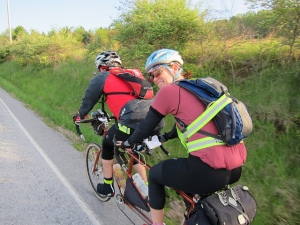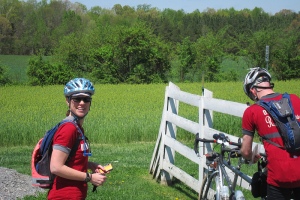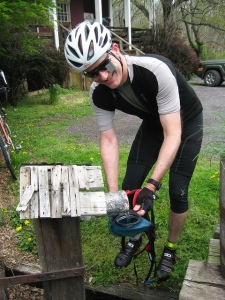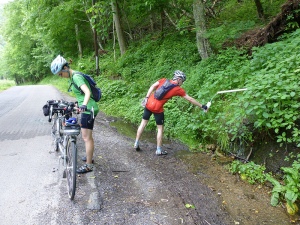
I generally like the look of most of my cycling clothing and gear with the exception of a few items such as booties, balaclavas, and the topic of today’s post, my Camelbak. However, much as I dislike the overall aesthetic, you will not see me on a brevet or bike tour without some kind of hydration pack.

On one hand, hydration packs are largely unattractive and all my ride photos show my back with a slight Quasimodo-esque hump. To be comfortable and to keep the Camelbak from sliding around, I have to be sure to adjust the straps just so.
My Camelbak adds weight to my back and shoulders. Fortunately that creates no issues when I ride, but in hotter months my back sweats up from wearing one. Sometimes the Camelbak can be tricky to fill, since many establishments have automatic faucets or shallow sinks.

Despite these down-sides, the functionality of a Camelbak makes it one of my reluctant brevet and touring necessities. With a Camelbak, I can carry an ample supply of water a few inches away from my face.
I seldom worry about not drinking enough or even running out of water. The Camelbak makes drinking super-convenient, and no reaching is required. (On our tandem, the water bottle cages are particularly low and awkward for me to reach).
Felkerino and I always carry an extra bottle or two on the bike, but we don’t have to worry about drinking directly out of bottles that may have collected road grit and who knows what from the farm roads.
If I start to run low on water in my Camelbak, I can transfer from a bottle when I get a free moment off the bike. The bottle is easy to refill at a convenience store or lunch stop. I’ve also become rather skilled at finding gas station utility sinks, which makes refilling the Camelbak easy.

Both Felkerino and I only use water in our Camelbaks so they are easy to clean. Other drinks find a home in one of the bottles on the bike.
I purchased a reflective backpack/Camelbak cover from L2S that is ideal for use on brevets, as I don’t have to worry about my Camelbak covering up my reflective vest. I purchased mine at one of the local sporting goods stores in the start town of Paris-Brest-Paris in 2011, and have not seen these sold in the United States. I do not even know if L2Sis still in existence, but some of the e-retailers across the pond look like they sell similar items.

Currently I use a Camelbak Rogue for bike rides. At 70 ounces, the bladder is ample, but not excessively large. The Rogue comes with a sternum strap, but not a waist strap, for stabilization. Since I use it for cycling, the sternum strap setup is ideal. When I run, I need a pack with both a waist and sternum strap to keep it from bouncing around.
The pockets on the Rogue allow me to carry my wallet and other small necessities such as my phone and brevet card. The Rogue also offers an additional internal pocket within the bottom pocket area where I securely stow my interchangeable lenses for my glasses.

I used a women’s-specific Camelbak previously, but found that it was too short for me (I’m 5’8″ tall). I wanted the Camelbak to sit lower on my back, and even though the shoulder straps are spaced a pinch wider than I would like, overall the standard Camelbak works fine for me.
My Camelbak has been good to me. It’s a tried and true piece of gear that has helped me through many a ride, especially during warmer months. I may not like how it looks on me, but all of that fades into the background when I’m riding free from worry about when we’ll reach the next water stop.
Comments & questions welcome – moderated for trolls and spam.